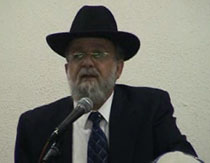Beit Midrash
- Sections
- Chemdat Yamim
- Parashat Hashavua
Teshuva (Repentance) – the very existence of the possibility of teshuva without direct connection to rectifying the tendency toward a specific sin implies closeness to Hashem. That is why our Rabbis taught us that teshuva preceded the creation of the world (see a list of seven such pre-creation creations – Pesachim 54a). That is why the days of teshuva begin in the beginning of the month of Elul.
Days of Judgment – Rabbi Yossi says that people are judged every day, and Rabbi Natan says that it occurs every moment (Rosh Hashana 16a). According to them, what is unique about Rosh Hashana? One can explain that during this special period, there is special closeness to Hashem, which stems from our willingness to be judged. When we exclaim that Hashem is the righteous judge of the whole world, people enter the path that ends with a sincere mindset of "For me, closeness to Hashem is good."
The Days of Selichot – The selichot are special prayers in the spirit of the days, which revolve around the recitation of the Thirteen Attributes of Mercy. These days prepare us for Yom Kippur and, especially, for the concluding prayer of Ne’ila, which is structured around the Thirteen Attributes. (They are absent from the davening of Rosh Hashana.)
During this period, Hashem promised that there would be special opportunities for mercy related to these prayers. As a matter of fact, the gemara (Rosh Hashana 17b) says that Hashem acted like a chazan and showed Moshe how to pray by mentioning the Attributes in a way that elicits the best results of forgiveness. Here too, through the description of Hashem’s Attributes, we draw ourselves closer to Him.
Sukkot – Entering the sukka has a clear significance of finding "protection under the wings of the Divine Presence." Having every limb in a person’s body within the sukka certainly gives expression to great closeness to Hashem, like entering a bridal canopy. The house that the sukka represents is the joint house of Bnei Yisrael and Hashem. The ushpizin, the historical great guests who spiritually grace our sukkot, are like the invited guests to the wedding. After all, a wedding without guests is hardly a wedding (this even has halachic implications). Certainly, anyone who enters the sukka is declaring: "For me, closeness to Hashem is good."
May we all merit, on these special days that begin our new year, to draw closer to Hashem and merit His forgiveness. Let us feel that "For me, closeness to Hashem is good."

Parashat Hashavua: “Kings Will Descend from You”
Rabbi Yossef Carmel | Kislev 5786

Parashat Hashavua: From Paroh to Hamas and Iran – In Those Days at this Time
Rabbi Yossef Carmel | Kislev 5786

You Always Need to Pray
Rabbi Yossef Carmel

Glory in the Clouds
Rabbi Yossef Carmel | 7 Shvat 5768

Rabbi Yossef Carmel
Head of "Eretz Hemda" Dayanut Kollel

Parashat Hashavua: A Torah of Life – part V – More on Yehoshua
Tammuz 5785

Rabbi Pinchas ben Yair Said: “Purity Leads to Sanctity”
5771

The Danger of the Fear of High Places
Parashat Vayetze
5764





















